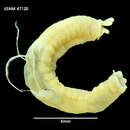zh-TW
在導航的名稱


“L EÆNA ARENILEGA Ehlers.
Ehlers (1913), p. 564, pl. XLIV, figs. 8-13. (Plate 9, figs. 95, 96.)
Two specimens only were obtained during this expedition, which is in contrast with the abundance of the worm off Kaiser Wilhelm II Land.
The present specimens show some apparent differences in the structure of the “head” from that described by Ehlers, but whether these are due to differences of preservation, or of interpretation, or of state of development, or are specific, it is difficult to decide when so few individuals are available. But since the worms agree in all essential features with his account I attribute them to his species, but add figures to illustrate the apparent discrepancies.
The tube is long and narrow, measuring 100 mm. in length by 3 mm. in width. It is built up of a single layer of transparent, colourless sand-grains with a slight admixture of other material, such as sponge spicules ; the outer surface is rough, and the grains seem very loosely adherent. It is more or less undulating, as if it had been coiled amongst other objects.
The contained worm measures only 40 mm., exclusive of the tentacles, which add another 10-12 mm. to the length. It is nearly cylindrical, tapering only slightly posteriorly.
The body contains about 70 segments ; the intersegmental grooves, however, are very indistinct posteriorly, so that there may be more.
The tentacular platform (fig. 95) is low, and the post-tentacular region bears an irregularly double row of eye spots laterally, but this becomes a single row across the dorsum ; the right and left rows are continuous, whereas Ehlers found a short dorsal gap separating the two groups.
The first segment is very short on the dorsal surface, but becomes swollen and enlarged laterally (figs. 95, 96), projecting forward here. This glandular thickening extends almost to the mid-line on the ventral surface, but the right and left lobes become narrower as they approach one another and terminate in rounded lobes, separated by a very narrow, short, non-glandular area.
It is here that I find a difference from Ehlers' account. He represents a large oval, forwardly-directed "flap" of much greater extent, and this, instead of tapering oil towards the mid-ventral line, is here almost as long as it is higher up the sides, and the two lobes overlap.
The second segment is likewise short on the dorsal surface, but is swollen so as to form a transverse ridge, which crosses the dorsum and extends down each side as far as the margin of the first gland shield. It is quite a definite structure ; but in Ehlers' figure it seems to be confluent with the flap of the first segment. Possibly these structures are not at their full development in the specimens before me.
The first notopod is borne on the third segment, and the uncini commence on the fourth. On each of the segments 5, 6, and 7 there is, above the notopod, near the hinder margin of the segment, a low but distinct nephridial papilla.
There are 16-17 bundles of bristles, but there are only ten well-developed notopodial outgrowths.
The uncinigerous neuropods are short throughout the worm, and lateral in position. Anteriorly, as in the 15th segment, there are 19 uncini, but further back the number is reduced to 6 or 7. The uncini agree precisely with the description given by Ehlers, and differ from those of L. abranchiata Malmgren and from L. wandelensis Gravier.
The ventral gland shields number 11, and are quadrate in form, except the first four, which are narrower transverse glandular bands.
Locality.—
Commonwealth Bay, 15 fathoms (with T. ehlersi and Th. antarcticus).
Distribution .—Kaiser Wilhelm II Land.”
(Benham, 1921)
Leaena arenilega is een borstelworm uit de familie Terebellidae. Het lichaam van de worm bestaat uit een kop, een cilindrisch, gesegmenteerd lichaam en een staartstukje. De kop bestaat uit een prostomium (gedeelte voor de mondopening) en een peristomium (gedeelte rond de mond) en draagt gepaarde aanhangsels (palpen, antennen en cirri).
Leaena arenilega werd in 1913 voor het eerst wetenschappelijk beschreven door Ehlers.
Bronnen, noten en/of referenties